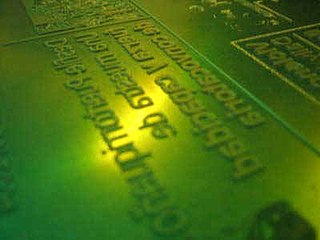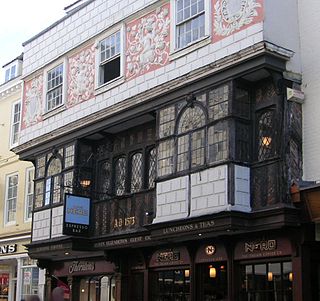
A printed circuit board (PCB), also called printed wiring board (PWB), is a medium used to connect or "wire" components to one another in a circuit. It takes the form of a laminated sandwich structure of conductive and insulating layers: each of the conductive layers is designed with an artwork pattern of traces, planes and other features etched from one or more sheet layers of copper laminated onto and/or between sheet layers of a non-conductive substrate. Electrical components may be fixed to conductive pads on the outer layers in the shape designed to accept the component's terminals, generally by means of soldering, to both electrically connect and mechanically fasten them to it. Another manufacturing process adds vias, plated-through holes that allow interconnections between layers.

Flexography is a form of printing process which utilizes a flexible relief plate. It is essentially a modern version of letterpress, evolved with high speed rotary functionality, which can be used for printing on almost any type of substrate, including plastic, metallic films, cellophane, and paper. It is widely used for printing on the non-porous substrates required for various types of food packaging.

BoPET is a polyester film made from stretched polyethylene terephthalate (PET) and is used for its high tensile strength, chemical and dimensional stability, transparency, reflectivity, gas and aroma barrier properties, and electrical insulation. A variety of companies manufacture boPET and other polyester films under different brand names. In the UK and US, the best-known trade names are Mylar, Melinex, Lumirror and Hostaphan.

Flexible electronics, also known as flex circuits, is a technology for assembling electronic circuits by mounting electronic devices on flexible plastic substrates, such as polyimide, PEEK or transparent conductive polyester film. Additionally, flex circuits can be screen printed silver circuits on polyester. Flexible electronic assemblies may be manufactured using identical components used for rigid printed circuit boards, allowing the board to conform to a desired shape, or to flex during its use.

Aluminium foil is aluminium prepared in thin metal leaves. The foil is pliable, and can be readily bent or wrapped around objects. Thin foils are fragile and are sometimes laminated with other materials such as plastics or paper to make them stronger and more useful.

Lamination is the technique/process of manufacturing a material in multiple layers, so that the composite material achieves improved strength, stability, sound insulation, appearance, or other properties from the use of the differing materials, such as plastic. A laminate is a permanently assembled object created using heat, pressure, welding, or adhesives. Various coating machines, machine presses and calendering equipment are used.

Thermal printing is a digital printing process which produces a printed image by passing paper with a thermochromic coating, commonly known as thermal paper, over a print head consisting of tiny electrically heated elements. The coating turns black in the areas where it is heated, producing an image.

A label is a piece of paper, plastic film, cloth, metal, or other material affixed to a container or product, on which is written or printed information or symbols about the product or item. Information printed directly on a container or article can also be considered labelling.

Wrap advertising or a vehicle wrap is known as the marketing practice of completely or partially covering (wrapping) a vehicle in a vinyl material, which may be for a color change, advertising or custom delivery. The result of this process is essentially a mobile billboard. Wrap advertising can be achieved by painting a vehicle's outer surface, but an increasingly ubiquitous practice in the 21st century involves the use of large vinyl sheets as "decals". The vinyl sheets can later be removed with relative ease, drastically reducing the costs associated with changing advertisements. While vehicles with large, flat surfaces are often used, automobiles can also serve as hosts for wrap advertising, despite consisting of more curved surfaces. Wrap advertising is also used in the magazine and publishing industries.
A platen is a flat platform with a variety of roles in printing or manufacturing. It can be a flat metal plate pressed against a medium to cause an impression in letterpress printing. Platen may also refer to a typewriter roller which friction-feeds paper into position below the typebars or print head. It can refer to the glass surface of a copier, and the rotating disk used to polish semiconductor wafers.
Cold roll laminators use a plastic film which is coated with an adhesive and glossy backing which does not adhere to the glue. When the glossy backing is removed, the adhesive is exposed, which then sticks directly onto the item which needs to be laminated. This method, apart from having the obvious benefit of not requiring expensive equipment, is also suitable for those items which would be damaged by heat. Cold laminators range from simple two roller, hand-crank machines up to large and complex motor-driven machines with high precision rollers, adjustable roller pressure, and other advanced features.

A countertop, also counter top, counter, benchtop, worktop or kitchen bench, bunker is a raised, firm, flat, and horizontal surface. They are built for work in kitchens or other food preparation areas, bathrooms or lavatories, and workrooms in general. The surface is frequently installed upon and supported by cabinets, positioned at an ergonomic height for the user and the particular task for which it is designed. A countertop may be constructed of various materials with different attributes of functionality, durability and aesthetics, and may have built-in appliances, or accessory items relative to the intended application.

Architectural glass is glass that is used as a building material. It is most typically used as transparent glazing material in the building envelope, including windows in the external walls. Glass is also used for internal partitions and as an architectural feature. When used in buildings, glass is often of a safety type, which include reinforced, toughened and laminated glasses.

Laminated object manufacturing (LOM) is a rapid prototyping system developed by Helisys Inc. In it, layers of adhesive-coated paper, plastic, or metal laminates are successively glued together and cut to shape with a knife or laser cutter. Objects printed with this technique may be additionally modified by machining or drilling after printing. Typical layer resolution for this process is defined by the material feedstock and usually ranges in thickness from one to a few sheets of copy paper.
In-mould labelling is the use of paper or plastic labels during the manufacturing of containers by blow molding, injection molding, or thermoforming processes. The label serves as the integral part of the final product, which is then delivered as pre-decorated item. Combining the decoration process with the moulding process cuts the total cost, but can increase the manufacturing time. The technology was first developed by Owens-Illinois in cooperation with Procter & Gamble to supply pre-labelled bottles that could be filled on the product filling line. This was first applied to Head & Shoulders shampoo bottles.

Laminated glass is a type of safety glass consisting of two or more layers of glass with one or more thin polymer interlayers between them which prevent the glass from breaking into large sharp pieces. Breaking produces a characteristic "spider web" cracking pattern when the impact is not enough to completely pierce the glass.

Roll slitting is a shearing operation that cuts a large roll of material into narrower rolls. There are two types of slitting: log slitting and rewind slitting. In log slitting the roll of material is treated as a whole and one or more slices are taken from it without an unrolling/re-reeling process. In rewind slitting the web is unwound and run through the machine, passing through knives or lasers, before being rewound on one or more shafts to form narrower rolls. The multiple narrower strips of material may be known as mults or pancakes if their diameter is much more than their width. For rewind slitting the machine used is called a slitter rewinder, a slitter or a slitting machine – these names are used interchangeably for the same machines. For particularly narrow and thin products, the pancakes become unstable, and then the rewind may be onto a bobbin-wound reel: the rewind bobbins are much wider than the slit width and the web oscillates across the reel as it is rewound. Apart from the stability benefit it is also then possible to put very long lengths,, onto one bobbin.
A heated roll laminator uses heated rollers to melt glue extruded onto lamination film. This film is in turn applied to a substrate such as paper or card using pressure rollers. The primary purpose of laminating with such a machine is to embellish or protect printed documents or images. Heated roll laminators can vary in size from handheld or desktop pouch laminators to industrial sized machines. Such industrial laminators are primarily used for high quantity/quality output by printers or print finishers.

A retort pouch or retortable pouch is a type of food packaging made from a laminate of flexible plastic and metal foils. It allows the sterile packaging of a wide variety of food and drink handled by aseptic processing, and is used as an alternative to traditional industrial canning methods. Retort pouches are used in field rations, space food, fish products, camping food, instant noodles, and brands such as Capri-Sun and Tasty Bite.
Heat transfer vinyl, or HTV for short, is a speciality polyurethane with a heat-activated adhesive that can be used on certain fabrics and materials to apply designs to promotional products, textiles and apparel, such as T-shirts. It comes laminated together with a clear polyester carrier in a roll or sheet form, with an adhesive tacky backing, so it can be cut, weeded, and placed on a substrate for application via a heat press. The design is cut into the material with a cutting plotter in reverse. The excess material is removed with tools such as hooks or tweezers - a manual and dextrous process referred to as "weeding". The tacky adhesive between the carrier and the vinyl holds together complex designs, although the labour naturally increases the more weeding that is required. The clear polyester carrier keeps the design visible to aid positioning on the substrate. For these and other reasons, it is a popular and more robust alternative to transfer paper. Heat transfer vinyl is made in single colors and also has special options such as patterned, glitter, flocked, holographic, glow-in-the-dark, reflective and 3D puff. Heat transfer vinyl also benefits from a high degree of stretch and rebound, achieved by a memory effect, making it suitable for use on apparel and other flexible items including the garments typically used, such as sports jerseys.















